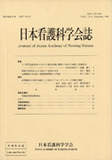Japanese
English
- 販売していません
- Abstract 文献概要
- 参考文献 Reference
要旨
与薬業務の安全性に影響する因子について,看護業務環境(患者の看護度,看護婦数など)や病棟での薬剤使用量(内外用剤)の面から検討した.病床規模約600床の大学病院で,病棟に勤務する看護婦約230名を対象にした質問紙調査を実施した.一般診療科における回収数は2,157,うち病棟で勤務した分は1,324,回収率は9月と10月あわせて90.4%であった.患者の看護度については,婦長を対象に質問紙調査を行なった.
調査期間中(延べ2週間)の与薬ミスは61回,ニアミスは118回,医師のオーダーに関するエラーは88回,他者のエラーに対処したのは141回であった.勤務全体の12%において,看護婦は何らかのエラーに対応していた.与薬ミス・ニアミスの発生に対しては「看護必要度が高い患者数」と「病棟での薬剤使用量(内外用剤)」が影響していた.また,「勤務者あたりの看護度スコア」が高いとエラーのリスクが高く,低いとエラーへの対処行為が多い傾向がみられた.対象病院では,患者の重症度や薬剤量の影響を最も受けていたのは準夜勤であった.与薬業務の安全性を指標化することによって,安全性に影響している因子を特定でき,質保証につなげることができる.
Abstract
The purpose of this paper is to identify any potentially hazardous errors that may occur in the nurses working environment and to develop a system that can protect against any such occurrences. For this purpose, the author examined characteristics and dosage of medicines used in each ward, and also interviewed nurses regarding their experiences with such problems in the work place.
The research was conducted at a 600-bed hospital which employed approximately 300 nurses. Questionnaires were distributed to 230 nurses, who were working in various wards, on September 1st through 7th and again on October first through 7th, in 1994. The author asked nurses to identify medication errors that they had personally been involved in during their working day.
This paper is concerned with 10 general wards in the hospital and the questionnaire response rate was 90.4%. 2,157 questionnaires were returned with 1,324 having been written on work days and the remaining information having been provided by head nurses. This information also included unit sizes, case mixes, staff lists and staff schedules.
In the course of the two weeks the research revealed a total of 61 medication errors, 118 near misses, 88 prescription errors which nurses identified, and 141 medication errors made by others which nurses actually dealt with. Results show that the nurses had not made any medication errors on 95.6% of their entire work days (1,324) and that on 12.4% of 1,324 work days nurses dealt with errors made by others.
The number of patients in serious conditions along with the amount of oral medication consumed had a direct influence on the number of medication errors. There is also a correlation between the Care-need-score divided by the number of nurses on duty (especially the evening-shift) and the number of error occurrence.
Several limitations of this study dictate that the results be applied with caution. However, the results might also be helpful in determining factors which can lead to the occurrence of various errors which put patient safety at risk.
Copyright © 1995, Japan Academy of Nursing Science. All rights reserved.


